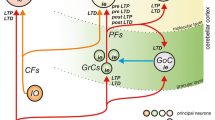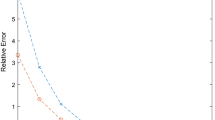Abstract.
Long conduction delays in the nervous system prevent the accurate control of movements by feedback control alone. We present a new, biologically plausible cerebellar model to study how fast arm movements can be executed in spite of these delays. To provide a realistic test-bed of the cerebellar neural model, we embed the cerebellar network in a simulated biological motor system comprising a spinal cord model and a six-muscle two-dimensional arm model. We argue that if the trajectory errors are detected at the spinal cord level, memory traces in the cerebellum can solve the temporal mismatch problem between efferent motor commands and delayed error signals. Moreover, learning is made stable by the inclusion of the cerebello-nucleo-olivary loop in the model. It is shown that the cerebellar network implements a nonlinear predictive regulator by learning part of the inverse dynamics of the plant and spinal circuit. After learning, fast accurate reaching movements can be generated.
Similar content being viewed by others
Author information
Authors and Affiliations
Additional information
Received: 8 February 1999 /Accepted in revised form: 7 August 1999
Rights and permissions
About this article
Cite this article
Spoelstra, J., Schweighofer, N. & Arbib, M. Cerebellar learning of accurate predictive control for fast-reaching movements. Biol Cybern 82, 321–333 (2000). https://doi.org/10.1007/s004220050586
Issue Date:
DOI: https://doi.org/10.1007/s004220050586




